Doing your own print run
… and why every self-published author should do one (at least once)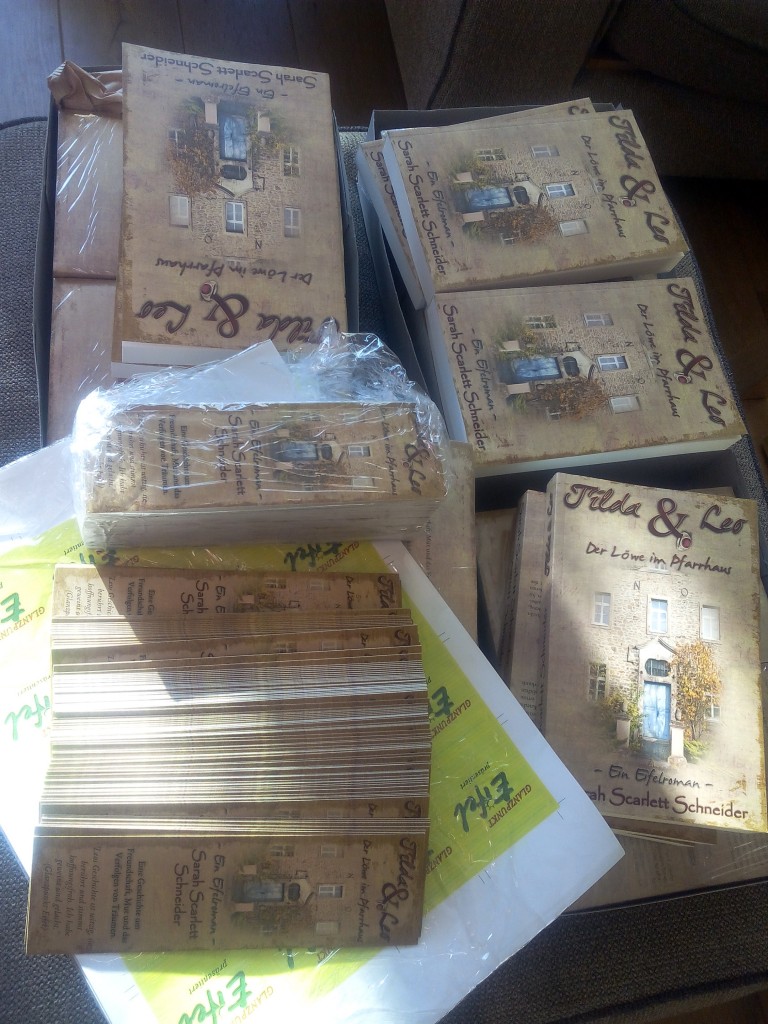
Many author-colleagues asked me how and where and why I did my own print run and sell “Tilda & Leo” in part by myself. I totally had all these questions, too, a few weeks ago, and now will answer how I did it, with probably more posts on the topic to come.
Preconditions
My historical Eifel novel “Tilda & Leo” is NOT your usual, English-speaking, internationally selling novel with a broad audience. It started life as a serialised novel in a German, regional magazine, Glanzpunkt Eifel, which focusses on the pleasures of living and working in the rural Eifel region. The story was meant to be entertaining and tied to the past and present of Eifelers. So I wrote the monthly instalments and in the background the respective novel, from which the instalments were extracted and published, while finishing “the book”.
I aimed for a November-publication to help marketing it for Christmas. I can highly recommend it for every self-publisher, especially if their book has some regional/local ties that could interest the audience! I easily tripled my sales, because most buyers said they want Christmas gifts for friends, family, etc. Most of them already knew the story-line from the magazine, or trusted my writing, and straight away ordered several copies.
It was clear that I’d self-publish with Amazon for easy print-on-demand and ebook-supply. I’d recommend that for ANY book, you never know the results you may get. And you need a proper place to send your customer to, for buying and leaving reviews.
So make sure you have a professional cover that fits the story, and proper formatting. Then you can use all these bones for other outlets as well and do ebooks etc. wherever you see fit.
In addition to Amazon I published the ebook with tolino, which is the German ebook-distributor, comparable to Kindle, but for Germany. They serve the big retailers such as Weltbild, Thalia, Mayersche book stores etc. It was quick and easily done. Another sales-channel that made total sense for my German book.
Your own print run
And here’s the interesting part. I wanted to do my own, physical print run, because all my friends and family wanted the book, but signed and with dedication. I also needed a good supply with copies for readings, and I wanted to control the quality. Those readings will be organised by physical bookstores in the Eifel, those who also stock my book. I offered my novel (which has a strong regional connection) to some smaller, independent bookstores in exactly that region I’m writing about. And those who took it on, to sell it pre-Christmas, also asked for readings in their premises, which means more possible sales. So I needed books for all that.
I needed physical books that I could quickly get my hands on for book stores and readings, which I could sign and customise, and which gave me some profit ABOVE what Amazon-author copies would. For Germans, ordering Amazon author-copies from the US doesn’t make sense. Shipping and customs eat all the tiny profit. I had to go to a printing company, was my logic.
We spent some time researching printing companies in Germany (to ensure quality and reachability, there are so many tiny details to discuss and choose, I wanted to be able to communicate easily), compared offers and paper-samples. Most of them would give me a profit of around 5 Euro after printing costs, compared to just 1 from Amazon. A STRONG argument for putting all the work in. (Side-note: my lovely friend, crime-author Carla Vermaat from Cornwall, also uses her local printing company for her novels, and is very happy about the nearness and direct contact you get in order to create the books you really want with them!)
And it is a LOT of work if you want to organise your own print run. They need specific formatting of cover and text, you have to choose your paper quality for both, compare all the tiny details in which the companies differ, and calculate what best fits your needs. Never order too many books, or too few. My mistake was to order only 50 at first, being insecure about how many I’d sell, and right before Christmas I was sold out and had a problem as orders still came in for Christmas gifting! It was an anxious wait until the next print run arrived safely and in time! Phew. That time I’d doubled the order.
As marketing material for hand-selling and creating interest I also did bookmarks, to hand out to shops, interested people, etc. I put a small version of the cover on it, with teaser, blurb and buy-links. They got great praise and were torn from my hands, but they were another few evenings to prepare and of course, to PAY for, with insecure return.
So the most important and also difficult decision to make it “how many”! How many copies do you need, for now? How much additional material to hand out? Don’t make the mistake to fill your room with boxes of books which don’t sell. YOU pay for it all! The same goes for bookmarks, flyers and other stuff to accompany your release, with the important difference that those don’t are give-aways. YOU pay them anyway.
Placing the order
We chose a professional, available (meaning: I called and talked formatting etc., and they sounded COMPETENT and helpful!) printing company and delivered the book files. If possible, first order a sample-copy first to see what they’re capable of. Weigh up quality and costs. Ensure they keep their deadlines AND inform you about all changes to their schedule, as this can affect your sales! I was “out of books” for around two weeks and had to make lists of pre-orders for the next run, which isn’t ideal. Buyers also wanted to send some books as gifts by mail for Christmas, so letting them wait wasn’t good.
What I did was be careful, I’m the pessimistic type, and only ordered 50 books and 200 bookmarks for the first run. It was a mistake, but I couldn’t know it then. They took around two weeks to print and we had to poke the company several times to make sure they’d be on time. Especially before Christmas, make sure they remember your agreement.
My experience
Then the big day arrived. The postman hauled three huge boxes into my hallway. I was almost too excited to open them. MY BABIES were finally born, in my hands, to hold, caress and … sell. Ahem. And god, were they beautiful! The covers felt smooth and silky, I had definitely chosen the perfect paper (keep YOUR expenses in mind, though!) and it feels better than Amazon’s books, which are ok, but not quite as good. 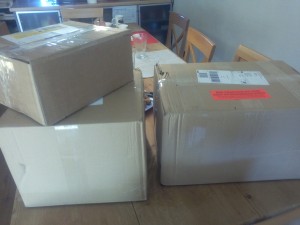 The bookmarks were equally handsome, with an invisible protective film as they’d be touched a lot. And then I carried the boxes into my study and stopped and stared. Wow. MY books. A year’s work, finally ready to get new homes and be loved! It does make a huge difference that I “created” them all myself.
The bookmarks were equally handsome, with an invisible protective film as they’d be touched a lot. And then I carried the boxes into my study and stopped and stared. Wow. MY books. A year’s work, finally ready to get new homes and be loved! It does make a huge difference that I “created” them all myself.
Yes, it’s all NOT that romantic. I had a long list of people who wanted to buy the book (I made EVERYONE pay, even my parents, just to ensure I’d not go overboard and in the end give away too many for free and be left with printing costs and no profit! Writing IS work, and everyone so far has acknowledged that), and most of them wanted several copies, as Christmas or birthday presents. Why?
The main advantage is the book’s strong regional connection: It’s a historical novel about the Eifel, on the border of which I live and most of my friends and family and the magazine publisher is from. Everyone in my area can relate to Eifel or has ties with people from there. Of course, an Eifel book store would be more likely to stock my book than a Cologne-based one. I mentioned many of the villages IN my story, and people love reading about familiar places.
Using the regional connections
So if your book has some regional/local connections, USE them! Think about all the ways you could create interest in your story, because the familiar region is your advantage. Who will like it? People who know you, or your work, or the topic/region. The magazine publisher which did the serial instalments of course offers the book to their customers and book stores (even other stores), museums, retailers etc. – they have the local connections and I can use them. People who know me are likely to like the book (haha, because I say so!) and recommend it to their circle of people, or some even bought a pile and now slowly sell it to whomever they think fits. (My mother-in-law alone so far has sold over 40 copies! She works at a museum, she has several sports-groups and a huge circle of friends. It will all help to spread the word.) It’s just the FIRST step! I myself took 2 copies to my yoga-class, in the hope that someone might be interested (we don’t talk that much about our hobbies/work there) and surprisingly everyone wanted at least one copy, and not because they knew me so well and wanted to do me a favour, but because Eifel is something they relate to! I had to come back with a box of books and sold them all. And they read it and spread the word and came back for more copies as gifts, with dedication etc. from me 🙂
So my carefully chosen 50 books were sold within two weeks. 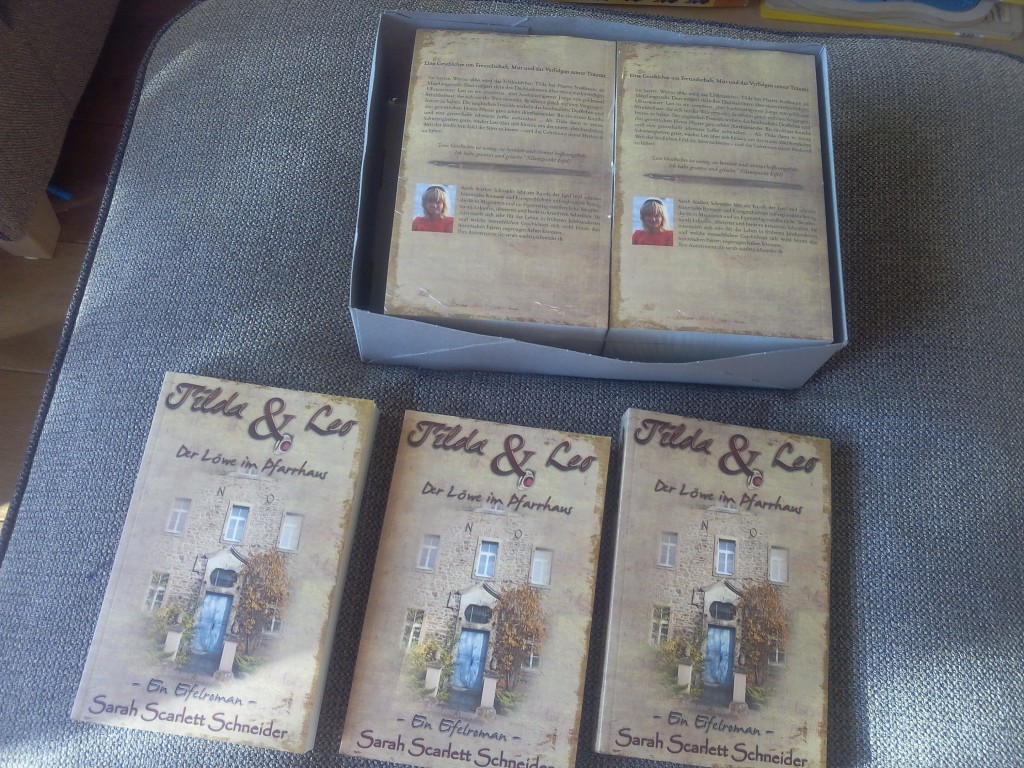 And people came back asking for more. My list of pre-orders grew. So we placed another order at the printing company, to serve my readers BEFORE Christmas, and things got on hold. They needed two weeks to deliver. They sent them via express in the end, and I got them just in time for whoever wants to mail them as Christmas gifts. Always keep these dates in mind and make sure there is still time for all this to happen! It’s rarely stress-free to schedule it all.
And people came back asking for more. My list of pre-orders grew. So we placed another order at the printing company, to serve my readers BEFORE Christmas, and things got on hold. They needed two weeks to deliver. They sent them via express in the end, and I got them just in time for whoever wants to mail them as Christmas gifts. Always keep these dates in mind and make sure there is still time for all this to happen! It’s rarely stress-free to schedule it all.
(Up the ante with your own hardcover-creation will be one of my next posts, though…)
Advantages of your own print run:
- you get insight into ALL the processes involved. It’s an invaluable learning-curve for every author, it’s wonderful and helpful to at least once go through all the different stages of elation and agony the physical creation of a book involves. It’s so much more “real”to have to decide every tiny detail yourself than just hitting “publish” on the Amazon-site. I’m a control-freak and I wanted to do it all, just once.
- Your own print run probably means you make more profit per sale. But you also have all the work.
- You get to handle your own money, physically. It’s something else to have people hand over their hard-earned money, in exchange for my book, the weight of their cash in my hand and wallet makes me want them to enjoy my work so much more! It means more.
- Plus: I suddenly was forced to learn how to handle all this cash and keep track of the comings and goings, the payments and investments.
- You can offer more special books, personalised, signed and with dedications, add a lovely bookmark and handshake and invite people to your readings.
- It’s much more personal! Selling via retailers is easy and I understand if someone doesn’t want to put the work in to do their own printing etc., it’s really not for everyone, and not for EVERY book. But the best experience of it all is that you see many of your buyers, get direct feedback, and I know under whose Christmas tree my book will lie! So many readers wanted gifts for “my mother”, “my sister”, “my uncle”… This thought is amazing. To know the readers and who of their loved-ones will unwrap my book as a present…is just lovely. It’s as un-anonymous as it can get, and very elating.
- The bond with your work is much stronger if you do it all yourself. I’ll also use some of the profit to reward myself for all the stress: in order to properly celebrate my writing/publishing year with those people who made it all happen and a success, I booked a lovely, booksy room in a restaurant, to practise my first reading, have a drink and toast with friends and family, and maybe sell one or two more books! More on that in one of my next posts. After that, I’ll feel ready to do the proper readings in the book stores, which are planned for January.
Risks of doing your own print run:
- You’ll not get rich this way. I have handled several hundred Euros now, investing in small print runs and getting money back with a profit, which I invested in the next run, and kept little to myself. You have to weigh it all up, always, especially the investment you make and how to get your money back, at least! That’s the hardest part of it all.
- It cost nerves and time and money. Things like formatting or adjusting a cover always take longer than one likes. You have to plan the release and marketing etc. beforehand and keep an eye on the schedule, poke the people involved and make sure everything runs smoothly and on time, how you want it. This may not be for everyone. It’s not for me, for every book. Just for special ones, like “Tilda & Leo”, and because of its regional content.
- You can never know how it will work, how much you’ll sell, and how much nerves it will cost to organise hand-selling events such as readings, sale to book stores, reading groups etc. Worst case: you sit on a pile of unsold boxes with no idea how to get your money back.
BUT: I would recommend the experience of doing it all on your own very much, at least, as I said, for one of your dearest book-projects, it’s a steep but valuable learning curve, exhilarating, rewarding, but also delicate to do, money-wise and marketing-wise.
I hope this post has given my interested friends some insight into how I did it and what they could do as authors, if they wanted to do their own print run as well. Maybe just once, and carefully, but it’s really a great experience that deepens the whole “creation”-side of writing!
Please let us all know if this post helped you make a decision, and if you did your own print run as well, or why you wouldn’t want to do it. That’s just as well 😉

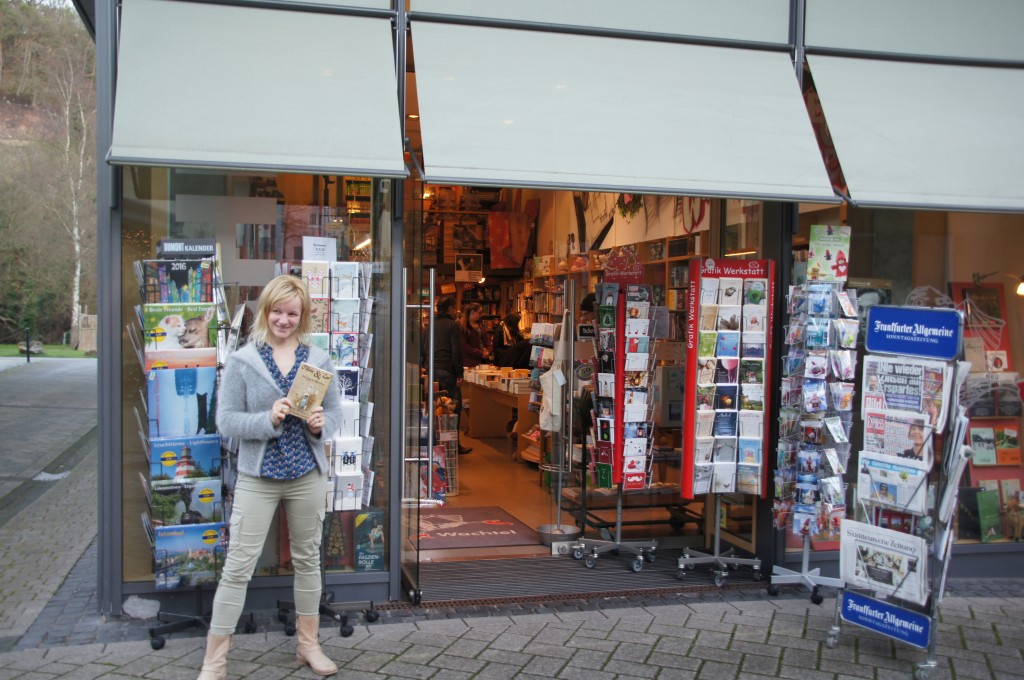
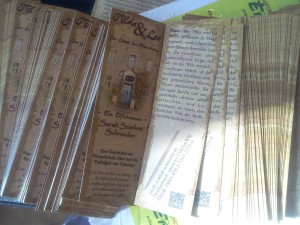
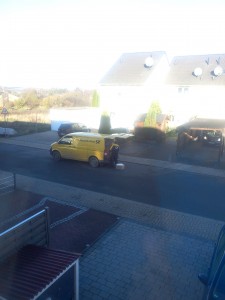


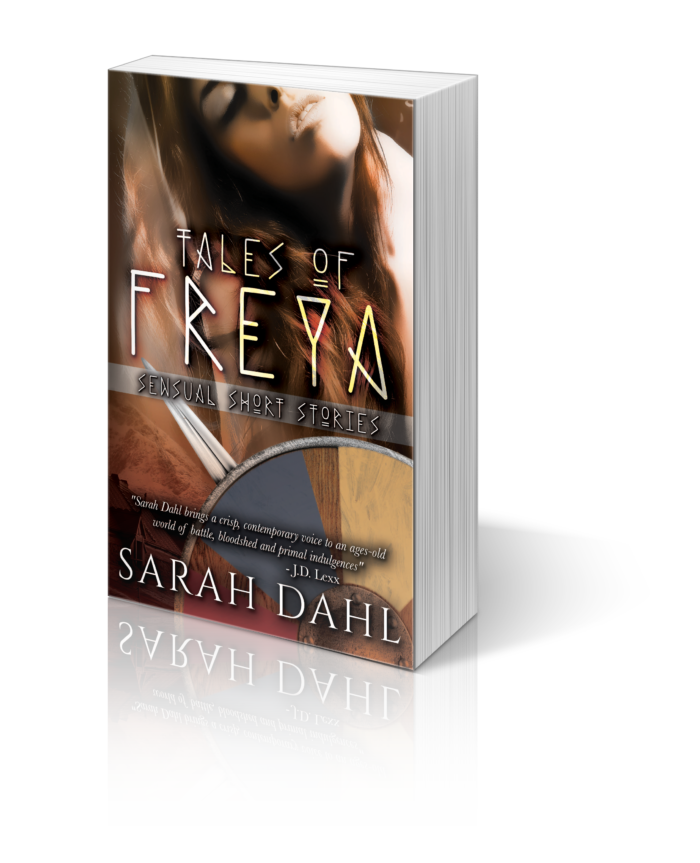
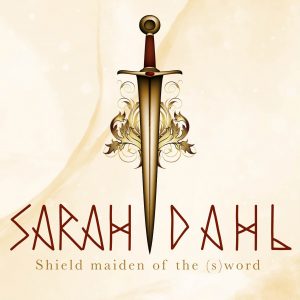
Comments (2)